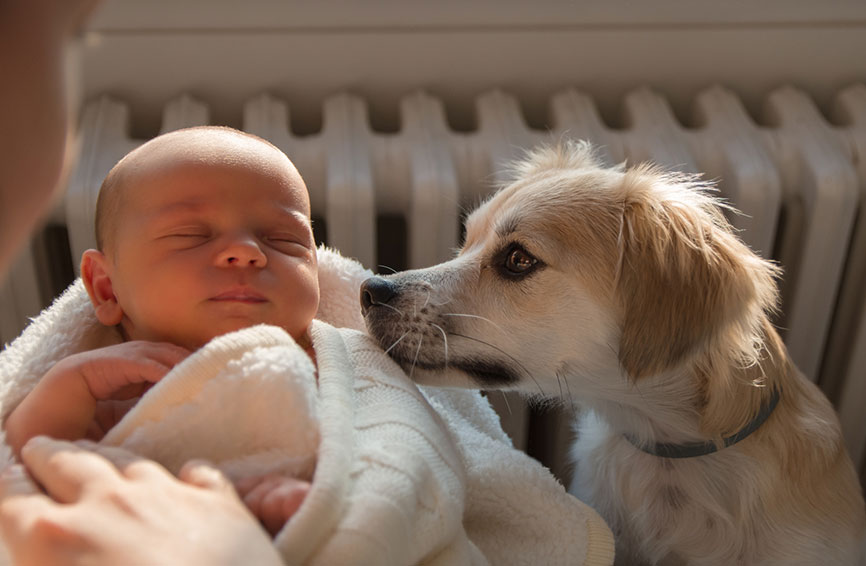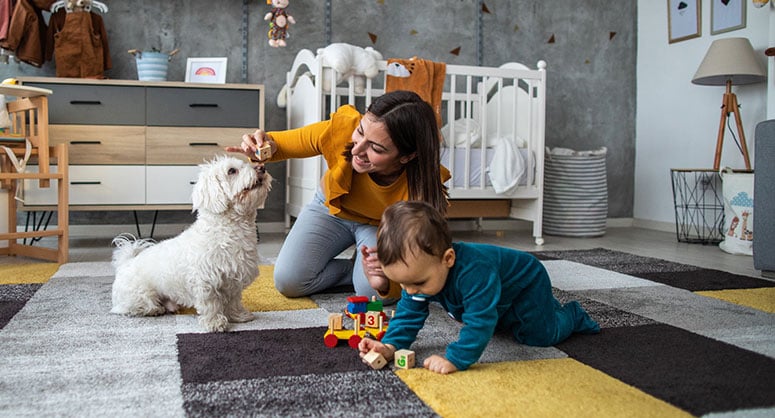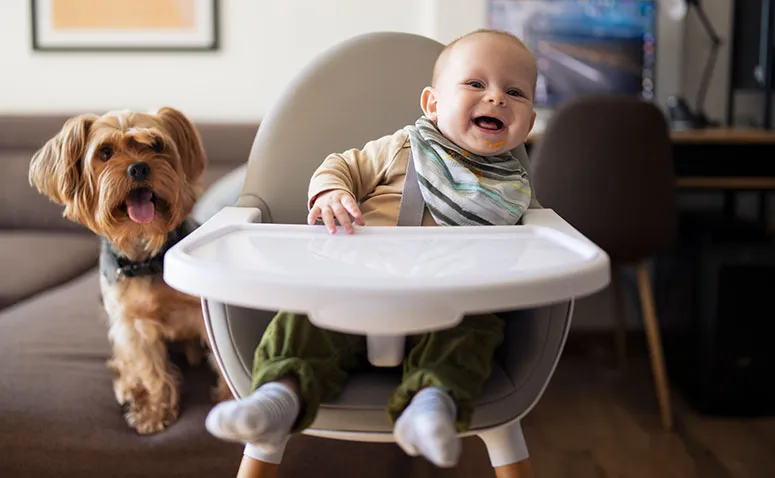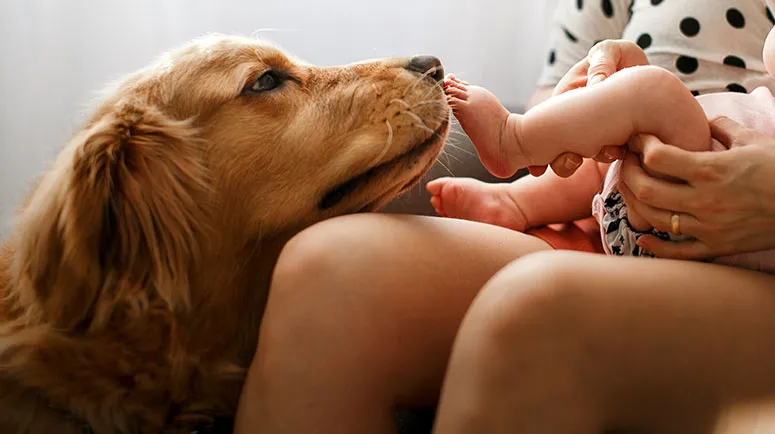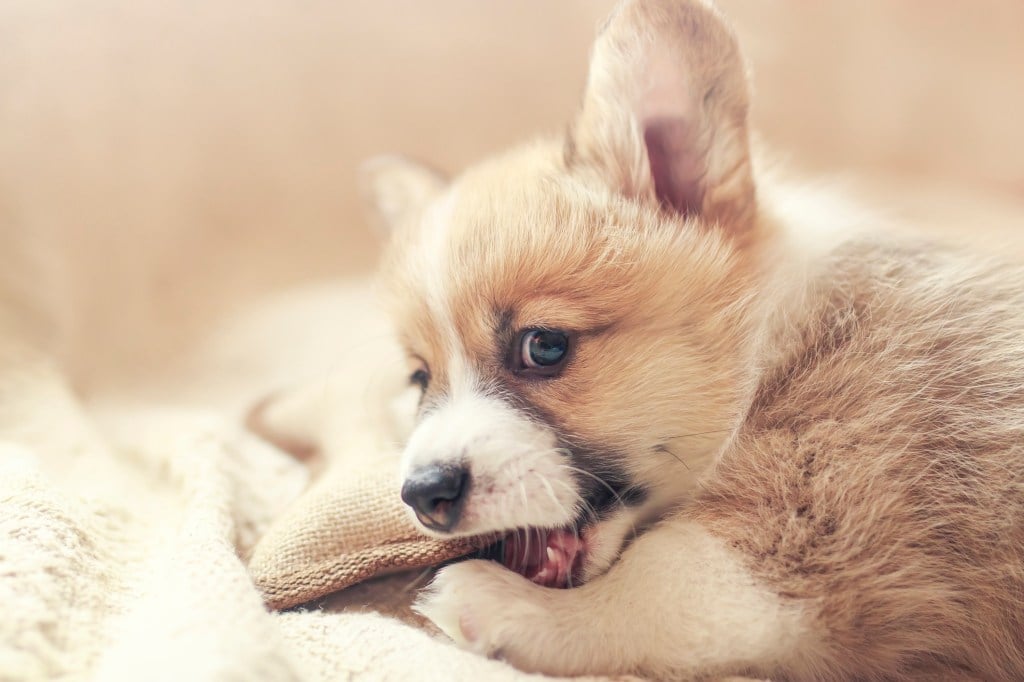Key Takeaways
- When you bring home a new baby, your dog won’t understand why they can’t sleep on your lap or on your bed as they used to, or why you seem to spend most of your time focused on someone else.
- You can ease this transition by preparing your dog ahead of time by introducing them to the baby’s sounds, smells and accessories.
- Once the baby arrives, set some boundaries and allow your dog to learn about the baby slowly – from a safe distance.
Table of Contents
When you are expecting a new baby, this is a big life change for you and a huge adjustment for most dogs. Especially if this is your first child, as many dogs are considered ‘the fur baby’ and have been given all the love and affection. After the baby is born, they will need to take a backseat to the baby’s needs.
Your dog won’t understand why they can’t sleep on your lap or on your bed as they used to or why you seem to spend most of your time focused on someone else. There will likely be other changes, like less playtime and shorter walks than they are used to. And every toy in sight will no longer be theirs to grab.
And, if you, as a new parent, are sleep-deprived, you may have less patience and energy, which could affect your tone of voice when speaking to your dog. Or your response to them when they do things to get your attention, which you used to think of as cute and amusing, may now be annoying. Addressing any habits you’d like your dog to change is much easier before your baby is born and will help you create harmony in your home for your whole family.
Preparing your dog well before baby is born
Taking advantage of the nine months before your baby is born is essential to start preparing your dog for the upcoming changes. A slow introduction to their new routine and life will help them adjust more easily.
Creating good habits of interaction between your child and dog
As your child grows up, you’ll want to teach them how to pet a dog gently, and where not to touch them. It’s unrealistic to expect every dog to be OK with a baby pulling its tail or grabbing fistfuls of hair. Most dogs feel uncomfortable being touched like this, and it hurts, so they may growl or nip to protect themselves. Children learn by example, so as you teach your child how to navigate the world around them, including how to respectfully interact with your dog while keeping your baby and dog safe.
What to do if your dog is nervous with children
Young children can be challenging for dogs to be around, especially once they start walking. They are at eye level, which can feel threatening, and when children are playing and running around, this may feel too chaotic for some dogs. When children cry or have meltdowns, it can be a stressful experience for dogs and cause them anxiety.
If a dog is nervous around young children or babies, they may need to be separated until the child is older and has learned how to interact with the dog appropriately. You can do this by using an X-pen or baby gate to keep your baby and dog separated. When your baby sleeps in their crib, this is a perfect time to bring your dog into the room with you for some love, affection, and playtime. Rotating your dog in and out of the room when your baby is sleeping will ensure they don’t feel left out and are still receiving the needed attention. Watching you and your baby from a safe space will also help your dog slowly adjust to your newest family member. Your dog should have a safe area to retreat to if needed; this also means preventing your baby or young child from entering that space or sticking their fingers through the gate.
Preparing your dog for a new baby
Helping your dog learn to be calm in the baby room
Set up the baby room months before your baby is born to establish the expectations of your dog around the baby. First, call your dog to you, clip their leash on, and as you walk them into the baby room, walk slowly. Make sure you keep the leash slack, as this process is not about teaching your dog to heel or controlling your dog; it’s about helping your dog learn to be calm in the baby room. If your dog leaves your side, calmly and immediately turn around and walk in the opposite direction for five steps, then stop and wait for about ten seconds. Then start walking again until you can sit in a chair in the baby room.
Don’t ask your dog to do anything, like “sit,” as you want to see when they relax on their own. Hold the leash like the stake in the ground and wait until your dog lays down. As they are relaxing, they may wander for a while, and you will see their body relax as they go from standing to sitting, and eventually, they will lie down. Don’t look at them or say anything once they are calm because if you interact with them, they will likely get up and move. This process is about teaching them to settle on their own and stay relaxed as they spend time with you.
You can practice this protocol in any room of the house so your dog clearly understands that they need to be calm when in the same room. The more you practice this, the more relaxed your dog will be, and eventually, you won’t need to walk them into the room on the leash because your dog will naturally be calm.
Setting boundaries
Enjoy reading a book or working on your laptop as your dog learns to settle independently. Don’t give them any attention. If they come over to you, calmly push them away with the palm of your hand. Don’t look at or talk to them as you do this because that will confuse them, as you will be giving them attention. The purpose of pushing them out of your personal space is to teach them that they will receive your attention only if invited by you for affection.
It will not hurt their feelings. Dogs find comfort when we start owning our space because we create a boundary that makes sense to them. If you don’t ‘own your space,’ your dog won’t respect it and will be more likely to demand attention and less likely to respond when you do call them to you or ask them to do something else.
Learning how to ‘own your space’ is important because once your baby is born, you cannot give your dog attention whenever they come over; you may be feeding your baby or rocking them to sleep. By teaching your dog to have a calm demeanor in the baby room, your dog won’t need to be excluded and will still enjoy spending time in the room with you.
Of course, you will want to give your dog attention, too, because your dog needs to feel loved and included and will need reassurance that they are still part of the family. Wait until they have stopped trying to invade your space, and are not looking at you for three minutes, then look at them and call them to you for a snuggle. You can give them as much love and affection as you want when they are invited. This will help you establish a calm atmosphere by creating these expectations so your dog understands that they need to wait to be invited for affection once your baby comes home.
How to teach your dog not to jump up on the couch
Teach your dog that you ‘own your space’ wherever you are in the house – this includes when you are sitting in the living room relaxing. Remember that if you are holding your baby on the couch and your dog is used to jumping up and getting attention whenever they want to, they will continue that behavior if you don’t teach them new rules.
Teaching them that they need to wait until you call them over for attention will help them have better manners when your baby arrives. If your dog jumps up on the couch without being invited, don’t look at them or talk to them; they will interpret that as getting your attention. Instead, calmly pull them off the couch. Wait until they have stopped trying to get your attention, then call them over for a snuggle, but give them affection while they stay on the ground.
Increasing the stimulation with common baby sounds
Once your dog follows your lead as you walk them into the room, not going ahead of you or demanding attention, it’s time to increase the stimulation in the room.
Once your dog has settled and is relaxing, hold a doll in your lap, wrapped in a baby blanket, and using your phone, play some typical baby noises, like crying. Sit, rock the doll, and talk to it, as you would your baby. It’s normal for a dog to be curious or even feel a bit nervous hearing crying noises, especially if they haven’t been around a baby before. Act calmly so your dog knows there’s nothing to be concerned about because you aren’t making a big deal about it. If you were to look at them, talk to them, and try and explain that it’s just the baby crying, it would confirm to your dog that something is wrong and cause them to feel anxious. You can also yawn to let them know everything is fine, as yawning is a comforting signal to dogs.
Introduce your dog to common baby smells
Just like baby sounds, you’ll want to get your dog used to baby smells, such as lotion, powder, diapers and bedding. Once the baby is born, bring an article of the baby’s clothing or a blanket home so the dog can get used to the infant’s scent. Give them treats when they sniff the items so they associate the odors with good things. By the time the baby comes home, your pooch will know and accept the strange new smell. Continue to give treats after the baby arrives to keep the positive association going.
As you do this, it is essential to set clear boundaries. Allow your dog to sniff from a distance while you are holding the item. By doing so, you are communicating to your dog that the item is yours and then giving permission for the dog to sniff. This helps start the process of creating respect and boundaries for the baby.
Help your dog learn that every toy isn’t theirs
If you are expecting your first child, and your dog has lots of toys around the house, they will naturally think that all the baby’s toys are for them too. So, teaching your dog to leave the baby toys alone is key.
Start by bringing one baby toy into the living room and putting it on the coffee table or couch. Walk your dog into the room on a leash, making sure that you follow the same protocol, so that they are calm coming into the room. The calmer your dog is, the easier it is for them to make good decisions.
- Walk parallel to where the toy is placed, far enough away so your dog can’t reach the toy. If your dog looks at the toy or lunges to grab it, say “Leave It” and say their name calmly.
- Wait about 10 seconds, and if your dog stops pulling towards the toy or looks at you for a moment, say, “Good, Leave It,” and give them a high-value treat.
- If they don’t respond to ‘Leave It’, escort them to a time-out. Taking them to a time-out means walking them to a small room, like a bathroom or laundry room, without acknowledging them.
- Turn the light on in the room for them, remove the leash, and leave them alone for three minutes.
- After three minutes, if they are quiet, walk into the room, clip the leash on, and repeat the training.
- If your dog is barking, whining, or scratching on the door, wait for them to pause, then open the door and repeat the training. If you open the door while they bark, whine or scratch they will believe their behavior caused you to open the door, and it will encourage them to continue this.
For dogs who scratch the door, you can purchase a door protector or tape cardboard to the back of the door to prevent scratch marks.
This will teach them that they made a mistake and the consequence of being separated from their family is something that dogs understand. When dogs make a mistake in a pack, the rest of the pack shuns them to let them know that they crossed a line.
As your dog appears less interested in the toy, slowly decrease the distance between your dog and the toy. Once they leave it alone, introduce a second toy and repeat the process.
How to teach your dog to stay on their dog bed
When your baby arrives, you may want to have them on the ground, on a blanket, as you play with them. Being on the ground is like inviting your dog to come over, so it could be difficult for your dog not to want to engage. To prevent this, teach your dog to stay on their bed when asked. And after playing with your baby, it’s best to pick up all the baby’s toys to prevent your dog from ingesting a toy.
- Call your dog to you and put a leash on them.
- Walk them over to their dog bed, and as soon as they stand on their bed, say “Bed” and use their name as you give them a treat.
- Walk away without saying anything or looking at them.
- Sit down in the room and continue ignoring them. Any acknowledgement is like starting a conversation, and they will be more likely to leave their bed.
- They can sit or lie down; the point is that they are settling on their own.
- If they leave their bed, walk over and step on the leash trailing after them, pick it up, and escort them back to their bed.
- When they are on their bed, say “Bed,” without giving a treat this time, and walk away.
- Repeat this process until they learn to stay on their bed.
- When releasing them from their bed, say “Come” and use their name.
Having a bone or toy available for your dog to entertain themselves while on their bed is helpful. You are not asking your dog to “stay” because you are not asking them to do anything but relax in a particular space. If you asked them to “stay,” they would expect you to give them another command. The purpose is for your dog to understand they must remain on their bed until released. The benefit of teaching your dog “Bed” is that you can move the bed to different rooms or take it on trips with you, knowing that you can include your dog while keeping your baby safe.
Keep in mind that if a dog has a bone, you need to ensure that you don’t allow your baby to crawl over to your dog, as your dog may guard the bone. Having your dog on their bed surrounded by an X-pen is a safe way to allow them to enjoy a yummy bone and keep your baby safe.
Introduce bigger baby accessories prior to baby’s arrival
Remember to introduce your dog to a baby swing, Johnny jump-up, and any other items you plan on using after your baby is born. If you wait and set them up when you are ready to use them, it could be stressful for your dog, especially if they get nervous with changes in the home. So, set one item up at a time and slowly help them get accustomed to it.
For example:
- Put the baby swing together and bring it into the living room for an hour in the evening as you relax.
- Ignore your dog, but watch, using your peripheral vision to see how your dog responds.
- If they are curious and investigate or don’t seem concerned, turn on the swing for a minute and notice their reaction.
- Once your dog seems calm with the swing moving, increase the time it swings. Then, increase the stimulation by putting a doll in the swing and playing some baby noises on your phone, which you have tucked into the swing with the doll.
Once baby has arrived
As your baby grows and becomes more mobile, it is a significant change for your dog, so having a slow adjustment period and a safe place to observe is critical. It can be challenging to keep your dog at a distance as your baby learns to crawl and walk because they may want to investigate and could easily knock your toddler down.
It’s best to use a baby gate or an X-pen to have a barrier between your dog and baby as your dog gets used to your baby being more active. The last thing you want is for your baby to fall on your dog or grab your dog’s tail, as most dogs will react instinctively and could nip your baby because they are startled, especially if your dog is asleep.
